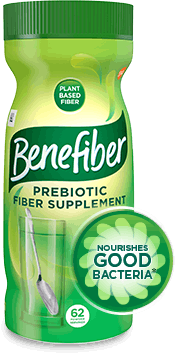Why Benefiber Is Different
A simple way to support good digestive health.*
Fiber & Your Digestive Health

When and How to Use Fiber Supplements

What Is Prebiotic Fiber?
Nourish the good microflora or good bacteria so they can thrive.
“Benefiber is an easy, no brainer way to get more fiber into your diet without any sacrifices in taste.”

9 Things Hurting Your Gut Health

9 Things Hurting Your Gut Health

When and How to Use Fiber Supplements
Our Products
An essential part of your wellness routine

All Benefiber products contain prebiotic fiber that nourishes the good bacteria that exist naturally in your gut and fits seamlessly into your lifestyle. *
Learn All About Fiber
Learn more about fiber with these resources.
§Prebiotic fiber supports digestive health.*
◊Prebiotic fiber supports metabolic energy, B-vitamins support cellular energy, and ginseng supports mental energy.*
* This statement has not been evaluated by the Food and Drug Administration. This product is not intended to diagnose, treat, cure, or prevent any disease.














